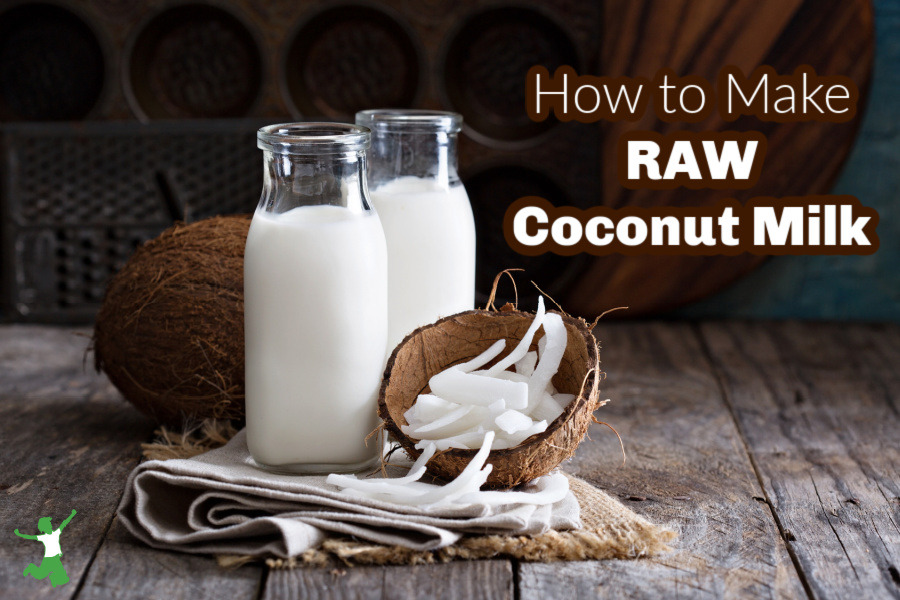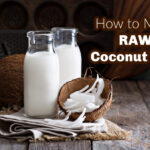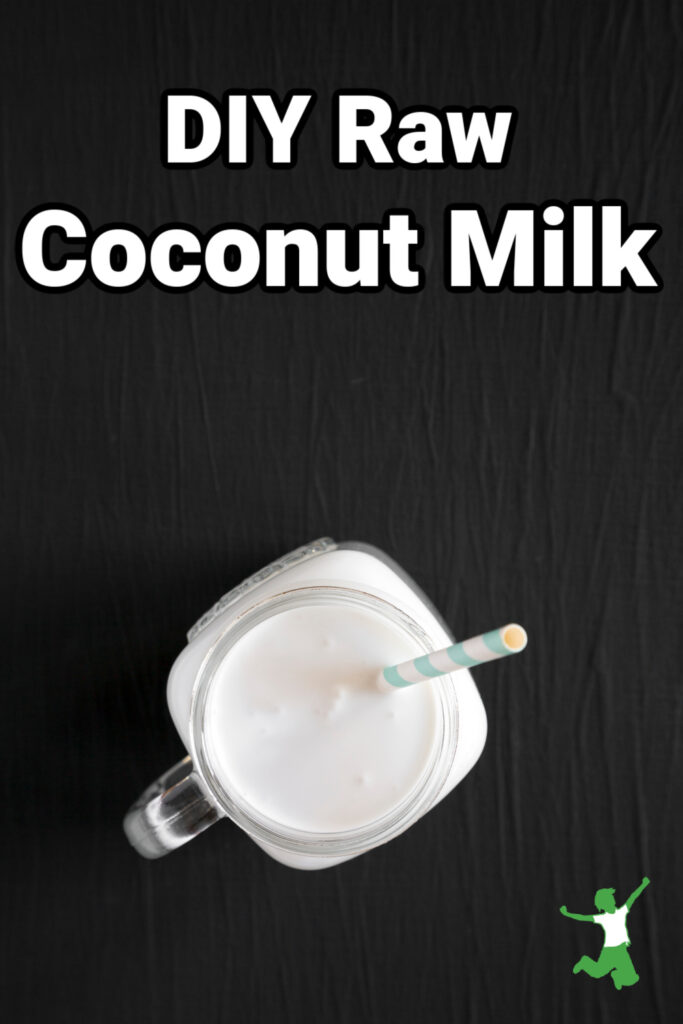Homemade raw coconut milk blended using fresh coconut meat and coconut water. Healthy, unprocessed, and enzyme-rich recipe which includes a video tutorial.

Two of the top items I buy at my local Asian Supermarket are bags of fresh coconut meat and young coconuts, which I use to make raw coconut milk.
High-quality coconut milk is a must-have staple in the kitchen. It is a much healthier option than hormone-disrupting soy milk.
The most highly desirable nutrient in coconut fat is lauric acid. The body uses this fatty acid for energy. It is also highly anti-microbial.
In fact, this lipid is so important to human health that the mammary gland makes lauric acid for breastfeeding babies! It is also present in a quality homemade baby formula recipe, but not in commercial brands even if organic.
Most homemade coconut milk recipes utilize boiling hot water to reconstitute desiccated coconut meat. This method is fine if you plan to make a cooked dish such as coconut milk pudding.
I personally prefer to make coconut milk in a manner that maintains rawness so that all enzymes and nutrients are intact.
This is important, especially for dairy-intolerant children who may consume it frequently as a healthy milk substitute.
If you prefer even more probiotics in your coconut milk, you can use this raw coconut milk and ferment it into coconut milk kefir.
The leftover coconut meat can be used to make homemade coconut flour for baking so that nothing goes to waste.

Homemade RAW Coconut Milk Recipe
Easy, homemade raw coconut milk you can make in minutes using fresh coconut meat and coconut water. Recipe includes video tutorial.
Ingredients
- 2 cups Frozen, raw coconut meat
- 1 young coconut
- 2 cups coconut water use if a young coconut is not available
Instructions
-
Thaw the frozen shredded coconut meat.
-
Open the young coconut as demonstrated in the video below and drain the coconut water into a bowl.
-
Place one cup of fresh coconut water and one cup of shredded coconut meat into a blender or food processor.
-
Blend until smooth. Check the consistency of the mixture. If it is extremely watery, add a bit more shredded coconut and blend again until smooth.
-
Pour coconut meat/coconut water mixture into a juicer to quickly strain out the coconut fiber. What is left is raw, whole coconut milk!
-
Alternatively, line a large bowl with a fine mesh cheesecloth or dishtowel and pour the coconut mixture into the bowl. Gather up the ends and squeeze out the coconut milk into the bowl.
-
Repeat to make one more cup of coconut milk. Making one cup of coconut milk at a time seems to work best in my experience so as not to overfill the blender and to achieve ideal consistency for the coconut milk.
-
Refrigerate the fresh, raw coconut milk. It will last for one week in the refrigerator.
Recipe Video
Recipe Notes
Raw coconut water brands from the store can be substituted for the fresh coconut water as desired if fresh young coconuts are unavailable.









Hi Sarah,
I seem to recall you saying in another coconut article that coconut is not sprayed or altered so it is not necessary to get organic? I assume this is the case if you are getting your coconut from the Asian Market? Thanks!
All very well if you live in or near a big city to get these items. I live 10 hours’ drive away from one.
Certainly, making raw coconut milk is not an option for everyone depending on location.
getting fresh coconut is not easy. can i use water instead of coconut water?
Yes, the recipe says this can be substituted. You can also use refrigerated coconut water that has been pressure treated instead of flash pasteurized.
Is Bob.s Red Mill Shredded Unsweetened Coconut raw? I am tired of chasing around for healthy ingredients since most that are recommended here are obscure in a less-than-urban area of 1 million people. I bought the above product at a local outlet of a national chain, paid a exorbitant price (in my opinion) and I cannot find out from any source if this is raw. Is it that important or is it the mantra of uninformed people?
Sarah any suggestion of what to do with the coconut pulp from the blender ? Can I make cookies or something like that ? If yes …¿can You share The recipe ? Thanks
Yes, check out my video on how to use it to make coconut flour 🙂
Hi Sarah, I enjoyed your post. I wanted to make a suggestion, if you don’t mind. I was born & live in Jamaica where we have a lot of coconuts and Jamaicans have been making coconut milk & oil for a very long time. I’ve only recently started making it myself but my relatives would make coconut milk every Sunday to cook rice & peas. Usually most people use the dry brown coconuts to make the milk. I have also used the more mature young coconuts with harder meat to make milk. The white coconut that you used is a young green coconut with the green skin chopped off (some commenters did not realize this). In Jamaica, we call the young coconut a jelly coconut & the meat is referred to as coconut jelly. I also use this kind of coconut, but I don’t usually process it at the same time as the dried one. I would mix or blend them together afterwards if a recipe calls for both. The young coconut meat can be used in a variety of desserts, but it can also be eaten straight out of the coconut, like the water. When blended it gives a creamy milk that does not need to be strained, whereas the mature coconut has to be strained of the fibrous pulp. Hope this was helpful.
Hello,
I enjoy drinking young coconuts. But what to do with the waste?
Cheers Th
Hi Sarah,
This is my second time asking. You never responded. About 4:40 into the video when you add some coconut meat from a glass measuring cup — you refered to it as dried shredded coconut. I thought that earlier you had said that we shouldn’t use dried shredded coconut because it needs to be reconstituted with boiling water. I’m wondering if maybe you were really using the frozen coconut meat but mistakenly called it dried shredded coconut meat?
Thanks Stacey
Stacey, I don’t know if you had gotten an answer to your question, but Sarah only used the frozen coconut meat & some fresh meat from a green coconut. She said it might look like the dessicated dried one but it wasn’t; it was wet to the touch. She made a mistake at the point you indicated when she said dry. Hope that helps.
Thank you Lorna! And “No” I have never received an answer from Sarah. She doesn’t seem to answer questions here. VERY FRUSTRATING.
how long does it last in the fridge ?
I’ve used a similar method in the past, successfully. Have to be careful as our only local Asian market didn’t keep their freezers in good working condition. Things would thaw and refreeze. Seriously dangerous (they’re out of business now, thankfully). They had cases of young coconuts but they were about $37 for 9 coconuts. I couldn’t justify that. The local regular grocery store has frozen coconut but one is ok quality, organic and in small packets (crazy expensive to make milk with it) but the other brand is loaded with preservatives even though it’s frozen. I prefer to use organic canned coconut milk, diluted, and add probiotics to culture if I . want. I get lots of enzymes in other ways so that doesn’t worry me of I skip that part.